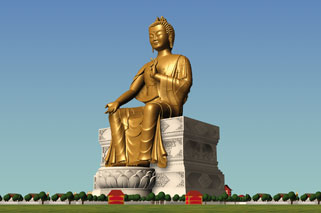Gautam Buddha was born in Lumbini (Kapilavastu) in 563 BC, he belonged to Shakya Kshatriya clan. His Father Suddhodhana was a king and mother Mahamaya was princess of Kosala. He was brought up by his aunt Goutami. He married to Yasodhara and had a son named Rahul. He left home when he was 29 years old to become a wandering ascetic. The event of leaving home known as Mahabiniskarmana. He joined five ascetics Kondana, Vappa, Bhaidiya, Mahanama and Assagi and became their leader.
At the age of 35 he achieved enlightenment at Uruvela (Bodh-Gaya) on the bank of Niranjana River (528 BC) His first Sermon is called Dharmachakra-pravartana. Buddha died in 483 BC in Kushinagar at age of 80. Event of his death is known as Mahaparinirvana.
The Councils of Buddhism
First Buddhist Council (400 BCE)
- Held soon after death of the Buddha
- Presided by monk Mahakasyapa
- Held by Magadh king Ajatasatru in Rajagriha
- Objective was to preserve the Buddha’s saying (suttas) and monastic rules (Vinaya)
Second Buddhist Council (4th Century BCE)
- Held about 100 years after the Buddha’s demise
- Held at Vaisali under the President Sabakami, convened by King Kalasoka
- Objective was to settle a debate on certain practices of Buddhist monks, exp. In western India
Third Buddhist Council (250 BCE)
- Held at Patliputra under the patronage of Ashoka
- Chief Monk was Mogaliputta Tissa
- Sent Buddhist missionaries to other countries
- Objective was to purify the Buddhist movement from opportunistic factions
- Origin of Theravada School
Fourth Buddhist Councils (1st Century BCE or CE)
- Possibly held under Theravada School in Tambabanni (Sri Lanka) in the 1st century BCE
- Committed the Pali Canon to writing
- Another possibly held under Saravastivada tradition, convened by Kanishka around 100 CE in Kashmir under the leadership of monk Vasumitra
- Kanishka’s council translated Abhidhama text from Prakrit to Sanskrit
The Schools of Buddhism
Theravada Buddhism
- Oldest surviving school of Buddhism
- Considered closest to early Buddhism
- Emerged from the Third Buddhist Council held under Ashoka at Pataliputra (c. 250 BCE)
- Introduced to Srilanka by Mahindra, the son of Ashoka, during the reign of Devanampiya Tissa
- Based on Pali Canon
- Practiced today in Sri Lanka, Burma, Laos, Cambodia, Thailand
Mahayana Buddhism
- Flourished from the 5th century CE onwards
- Patronized by the Gupta dynasty
- Nalanda University was a center of Mahayana learning
- Practiced today in Japan, China, Korea, Singapore and Vietnam
Vajrayana Buddhism
- Involves tantric practices
- Became prominent after the fall of the Gupta dynasty
- Tibetan Buddhism belongs to this tradition
The Texts of Buddhism
Pali Tipitaka (Pali Canon)
- Refers to three main books
– Vinaya Pitaka: contains disciplinary rules for Buddhist monks
– Sutta Pitaka: contains disclosure ascribed to the Buddha
– Abhidhamma Pitaka: systematic explanations of the Buddha’s teachings - The Pali Tipitaka is the only one to survive in its original language
- Originated from the First Buddhist Council (c. 400 BCE) under the leadership of monk Mahakasyapa
- Used primarily by the Theravada tradition
Mahayana Sutras
- Composed from the 1st century CE onwards
- Claim to articulated the Buddha’s more advanced doctrine of followers of the bodhisattva path
- Used by the Mahayana tradition.
Important Buddhist Sites
Lumbini (Nepal)
- Site of the Buddha’s birth
- In the present-day region of Tarai (Southern Nepal)
- Houses the Mayadevi Temple and Pusakarini or Holy Pond (where the Buddha had his first bath)
- It is a UNESCO World Heritage Site (1997)
Bodh Gaya (Bihar)
- Site of Buddha’s enlightenment
- Home of the Mahabodhi Temple constructed in 6th Century CE by the Guptas
- It is a UNESCO World Heritage Site (2002)
Sarnath (Uttar Pradesh)
- Site of Buddha’s first Sermon
- Place were the first Sangha came into existence
- Home of Ashoka’s famous Sarnath Pillar
- Contains the Dhamek Stupa Chaukhandi Stupa, Dharmarajika Stupa, Mulagandhakuti Vihara
- Presently on the UNESCO World Heritage tentative list.
Kushinagar (Uttar Pradesh)
- Site of Buddha’s death
- Contains the Mahaparinirvana Stups
- Houses the Mkutabandhana, cremation site of the Buddha
- Maitreya Project to build a 500 ft statue of Buddha
Sanchi (Madhya Pradesh)
- Houses several Buddhist Monuments from 3rd century BCE to 12th century CE
- The Great Stupa at Sanchi was commissioned by Ashoka in the 3rd century BCE
- It is a UNESCO World Heritage Site (1989)


